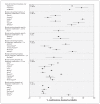Proportion of hospital readmissions deemed avoidable: a systematic review
- PMID: 21444623
- PMCID: PMC3080556
- DOI: 10.1503/cmaj.101860
Proportion of hospital readmissions deemed avoidable: a systematic review
Abstract
Background: Readmissions to hospital are increasingly being used as an indicator of quality of care. However, this approach is valid only when we know what proportion of readmissions are avoidable. We conducted a systematic review of studies that measured the proportion of readmissions deemed avoidable. We examined how such readmissions were measured and estimated their prevalence.
Methods: We searched the MEDLINE and EMBASE databases to identify all studies published from 1966 to July 2010 that reviewed hospital readmissions and that specified how many were classified as avoidable.
Results: Our search strategy identified 34 studies. Three of the studies used combinations of administrative diagnostic codes to determine whether readmissions were avoidable. Criteria used in the remaining studies were subjective. Most of the studies were conducted at single teaching hospitals, did not consider information from the community or treating physicians, and used only one reviewer to decide whether readmissions were avoidable. The median proportion of readmissions deemed avoidable was 27.1% but varied from 5% to 79%. Three study-level factors (teaching status of hospital, whether all diagnoses or only some were considered, and length of follow-up) were significantly associated with the proportion of admissions deemed to be avoidable and explained some, but not all, of the heterogeneity between the studies.
Interpretation: All but three of the studies used subjective criteria to determine whether readmissions were avoidable. Study methods had notable deficits and varied extensively, as did the proportion of readmissions deemed avoidable. The true proportion of hospital readmissions that are potentially avoidable remains unclear.
Figures


Comment in
-
How important is it to identify avoidable hospital readmissions with certainty?CMAJ. 2011 Apr 19;183(7):E368-9. doi: 10.1503/cmaj.110448. Epub 2011 Mar 28. CMAJ. 2011. PMID: 21444614 Free PMC article. No abstract available.
References
-
- Office of the Auditor General of Ontario 2010 annual report — discharge of hospital patients.Toronto (ON): Government of Ontario; 2010. p. 64–93 Available: www.auditor.on.ca/en/reports_en/en10/302en10.pdf (accessed 2011 Mar. 11)
-
- Harrell FE. Multivariable modeling strategies. Regression modelling strategies. New York (NY): Springer; 2001. p. 53–86
-
- DerSimonian R, Laird N. Meta-analysis in clinical trials. Control Clin Trials 1986;7:177–88 - PubMed
-
- Graham H, Livesley B. Can readmissions to a geriatric medical unit be prevented? Lancet 1983;1:404–6 - PubMed
Publication types
MeSH terms
LinkOut - more resources
Full Text Sources
Medical
